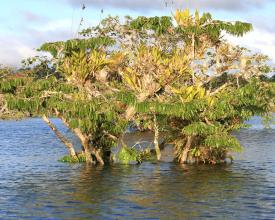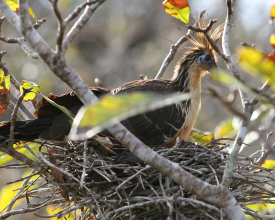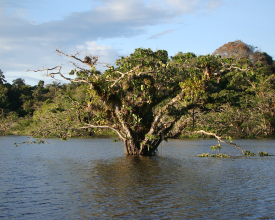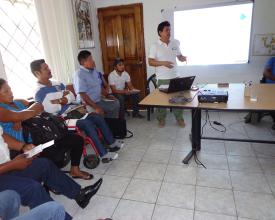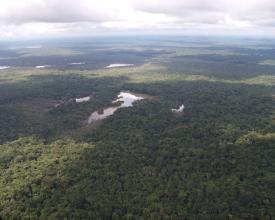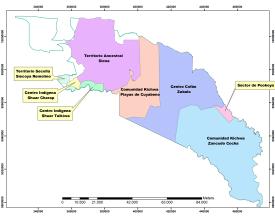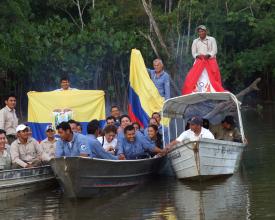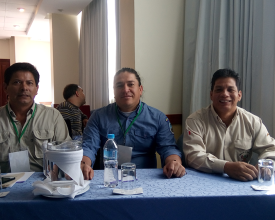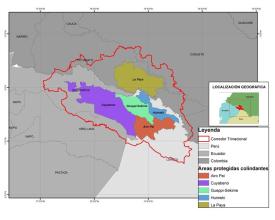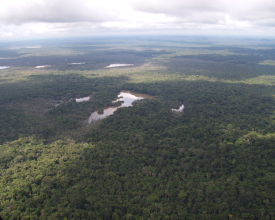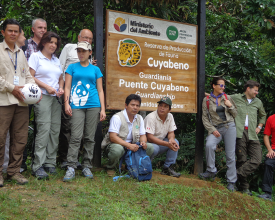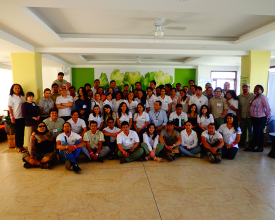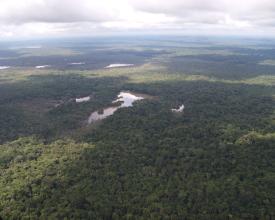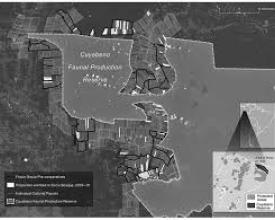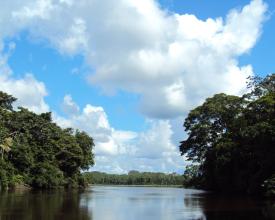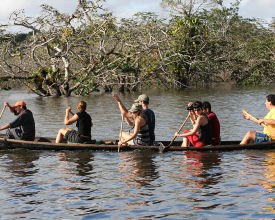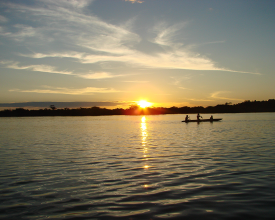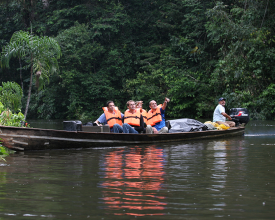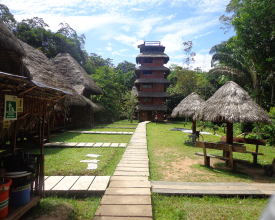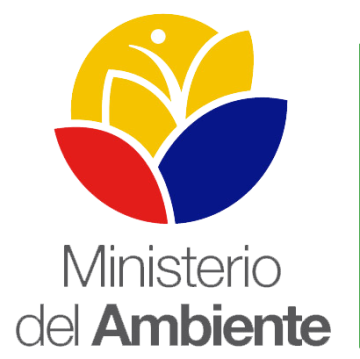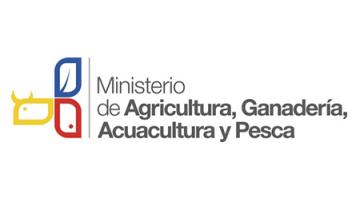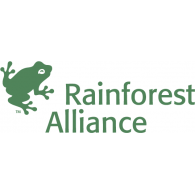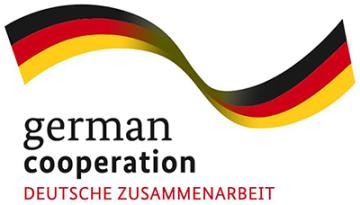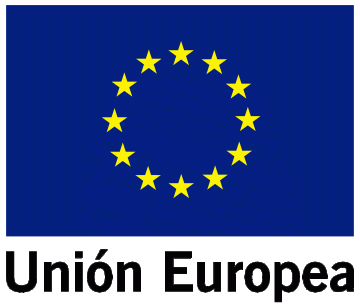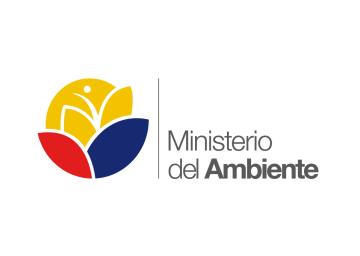
Un exemple de gouvernance et de participation des peuples et nations autochtones à la gestion de la réserve de faune et de flore sauvages de Cuyabeno, en Équateur

Plusieurs facteurs ont contribué à la consolidation de la réserve de faune de Cuyabeno en Équateur. L'un d'entre eux a été l'habilitation des organisations indigènes à établir des "accords d'utilisation et de gestion" avec l'État. En outre, le gouvernement a défini des politiques de conservation des zones protégées, telles que le programme Socio Bosque, le Fonds national pour l'environnement et les investissements dans le tourisme durable. Enfin, la disponibilité de fonds et d'une assistance technique de la part de la coopération internationale a été déterminante pour soutenir une initiative d'intégration transfrontalière (Colombie-Équateur-Pérou).
Contexte
Défis à relever
Les principales menaces qui pèsent sur la conservation de la réserve de faune de Cuyabeno sont les activités d'extraction pétrolière, l'extraction de bois, la chasse illégale, le trafic illégal d'espèces sauvages, l'agriculture selon le modèle de la monoculture, l'expansion des zones agricoles et la colonisation.
L'augmentation du tourisme est également un défi pour la réserve, car elle est située à un point d'entrée important pour la Basse Amazonie, et elle contient d'importantes valeurs naturelles et culturelles qui sont exploitées pour le tourisme.
Dans le domaine socio-environnemental, onze communautés indigènes de cinq nationalités différentes vivent à l'intérieur de la réserve, avec lesquelles il est nécessaire de conclure des accords pour l'accès à la propriété foncière et l'utilisation durable des ressources naturelles du territoire. Il s'agit d'un défi car l'objectif est d'articuler la vision de la conservation et de la gestion du territoire de ces communautés indigènes et de l'État.
Emplacement
Traiter
Résumé du processus
Les blocs de connaissances présentés dans cette solution ont contribué dans leur ensemble à améliorer l'administration de la réserve de faune de Cuyabeno. La disponibilité de ressources financières et d'une assistance technique a permis d'améliorer tous les aspects de la zone. Cela a été possible grâce à l'existence d'un Fonds national pour l'environnement spécifiquement destiné aux zones protégées, au renforcement des politiques qui encouragent les investissements dans le développement du tourisme, à la coopération internationale établie par le biais d'une initiative tri-nationale et à un système national d'incitation par le biais du programme Socio Bosque. À ces éléments s'ajoute l'existence d'accords de cogestion visant à promouvoir l'autonomisation et la participation des organisations indigènes de la région.
Blocs de construction
La cogestion entre les communautés autochtones et le gouvernement
L'un des grands défis de la réserve de faune de Cuyabeno a été la consolidation de ses limites et la conclusion d'accords de gestion avec les populations locales et les organisations indigènes. Dans la logique précédente d'intégration des variables culturelles dans le processus de préservation nationale, le projet "Délimitation de la région inférieure, résolution des conflits et sensibilisation des communautés à la gestion et à l'utilisation des ressources dans la réserve de faune et de flore sauvages de Cuyabeno" a été mis sur pied avec succès.
L'objectif principal du projet était de préserver l'intégrité biologique et culturelle de la réserve dans le cadre d'une alliance solide entre le MAE et les communautés indigènes qui habitent et coexistent sur le territoire : Siona, Secoya, Cofán, Kicwa et Shuar.
C'est ainsi qu'en 1995 a débuté le processus d'établissement d'accords d'utilisation et de gestion des ressources naturelles avec la plupart des communautés de ces cinq nations indigènes. Ces efforts ont favorisé la participation locale et la reconnaissance de la zone protégée pour une gestion partagée.
Les accords sont devenus des documents officiels qui ont légitimé le droit des communautés à vivre dans la réserve et à utiliser les ressources naturelles qui s'y trouvent dans des conditions particulières.
Facteurs favorables
- Renforcer les organisations indigènes pour qu'elles participent activement à la zone protégée.
- Stratégies de négociation entre les organisations indigènes et le gouvernement, afin d'établir les accords d'utilisation et de gestion.
- Ouverture du MAE aux processus de planification participative.
- Promotion de l'utilisation durable des ressources naturelles dans la zone protégée.
- Reconnaissance par les communautés locales de la pertinence de la zone protégée : importance environnementale, culturelle, sociale et économique.
Leçon apprise
Les accords d'utilisation et de gestion comprennent les éléments suivants : Des plans de gestion communautaire, des plans opérationnels et un système de contrôle de la conformité. Les plans de gestion communautaire sont valables pour dix ans et peuvent être renouvelés.
Les plans de gestion communautaires ont été élaborés en tant qu'accords internes par et pour la communauté, conformément à : Les règles d'utilisation des ressources naturelles dans les espaces communaux émises par la réserve ; Le statut actuel de l'utilisation de ces ressources ; et les droits des communautés indigènes. Les limites de la zone protégée et des territoires des communautés ont été consolidées.
En outre, des espaces de discussion ont été créés afin de traiter les points de vue convergents et divergents, y compris les visions indigènes et gouvernementales sur le territoire, sa conservation et sa gestion durable.
La cogestion de la zone entre le MAE et les organisations indigènes a permis d'obtenir un résultat important : L'arrêt de l'arrivée de nouveaux colons sur les territoires indigènes ainsi que la colonisation/expansion des communautés locales dans la réserve.
La gouvernance au-delà des frontières
L'initiative d'intégration de la frontière amazonienne, connue sous le nom de Programme tri-national, a été promue par les administrateurs de trois zones protégées (le parc national de La Paya - Colombie, la réserve de faune de Cuyabeno - Équateur, et le parc national de Güeppí - Pérou), permettant une optimisation de la gestion dans le cadre d'un modèle coordonné à l'échelle régionale.
Tout a commencé en 2005 grâce aux efforts de dialogue déployés par les représentants des trois zones protégées. En 2006, l'initiative a été consolidée sous la forme d'un programme trinational, qui n'a cessé d'être renforcé au fil du temps.
La première décision importante concernant le soutien financier de l'initiative a été prise par le biais d'un accord entre les fonds environnementaux disponibles dans chacun des trois pays participants. Par la suite, un soutien financier supplémentaire a été recherché à travers plusieurs projets qui pourraient couvrir les dépenses des lignes prioritaires telles que la gestion des zones protégées et des zones tampons, la participation sociale, l'amélioration de la capacité organisationnelle et l'amélioration du corridor de conservation.
Dans ce contexte, les gouvernements se sont unis pour rechercher des mécanismes opérationnels, techniques et financiers afin d'assurer la conservation et le développement durable du corridor, avec l'ambition de devenir une expérience pilote réussie de gestion transfrontalière.
Facteurs favorables
- Une vision commune entre les trois zones protégées pour résoudre des problèmes similaires dans la région frontalière.
- Une structure bien définie du programme selon des lignes directrices de gestion spécifiques, avec un comité de coordination (trois autorités nationales représentant chacun des systèmes nationaux des zones protégées), un comité technique (directeurs des trois zones protégées) et un secrétariat technique (siège tournant tous les deux ans entre les trois autorités environnementales).
- Obtention d'un soutien technique et financier de la part des agences de coopération.
Leçon apprise
Le contexte institutionnel du programme a été renforcé grâce à une structure solide composée du Comité de coordination, du Comité technique et du Secrétariat technique : Le comité de coordination, le comité technique et le secrétariat technique. En outre, un protocole d'accord a été signé par les parties, qui a fourni une ligne directrice claire pour le travail à venir.
Grâce au soutien technique et financier obtenu, plusieurs actions coordonnées ont été menées pour accroître la fonctionnalité et les capacités de gestion des trois zones. À Cuyabeno, les postes de garde ont été réparés et équipés, et le programme de surveillance et de vigilance a été consolidé dans le cadre du plan de gestion de l'aire ; plus tard, il a été articulé avec le travail des gardes forestiers dans les trois aires pour surveiller efficacement les points de conservation stratégiques à l'intérieur des aires protégées, des zones tampons et des frontières.
En ce qui concerne la participation sociale pour la gestion durable, le travail visait à renforcer la chaîne de productivité du café biologique et du cacao aromatique fin, ainsi que les initiatives de tourisme communautaire.
Le Fonds pour les zones protégées en tant que stratégie de viabilité financière
La création d'un fonds permanent destiné à couvrir les dépenses de gestion des zones protégées a aidé les administrations gérées par le gouvernement à disposer d'un budget annuel pour couvrir leurs principales activités opérationnelles, comme c'est le cas de la réserve de faune et de flore sauvages de Cuyabeno.
Ce fonds, officiellement connu sous le nom de Protected Areas Fund (PAF), a été créé dans le cadre d'une initiative lancée en 1999 par le ministère équatorien de l'environnement et le Fonds national pour l'environnement, avec le soutien d'organisations internationales. L'objectif principal était de diversifier les sources de financement des zones protégées publiques et d'assurer des ressources financières à long terme.
Le Fonds national pour l'environnement, créé en 1996, a servi de précédent au PAF. Il était considéré comme "un mécanisme financier indépendant disponible pour soutenir les plans, les programmes, les projets et toute activité visant la protection, la préservation et l'amélioration de l'environnement et des ressources naturelles". Ce fonds, créé en tant qu'organisation privée, administrait et canalisait les ressources financières, fournissait des conseils techniques, mais ne participait pas à la mise en œuvre directe d'une initiative.
Facteurs favorables
- Des politiques nationales ont été mises en place pour soutenir la création d'un fonds environnemental national, destiné à assurer la stabilité budgétaire du système national équatorien de zones protégées.
- Soutien financier constant de la part des agences de coopération nationales et internationales pour créer un fonds fiduciaire destiné à couvrir les coûts opérationnels et de gestion des zones protégées gouvernementales, y compris la réserve de faune et de flore de Cuyabeno.
Leçon apprise
La conception et la mise en œuvre du PAF sont le résultat d'un processus de négociation entre le gouvernement équatorien, la société civile et les agences internationales.
Son principal objectif est de fournir un soutien et une stabilité financière au système national équatorien des zones protégées, contribuant ainsi à la conservation in situ de la biodiversité de l'Équateur. Le PAF est destiné à cofinancer les dépenses opérationnelles de base et à fournir un soutien technique.
Après une interruption d'un an en 2015, le PAF travaille actuellement avec 30 aires protégées gouvernementales, dont la réserve sauvage de Cuyabeno, qui dispose d'un budget annuel de 56 000 USD. Même si le PAF n'est pas le seul mécanisme financier dont dispose la réserve, le budget annuel qu'il couvre soutient les principales activités opérationnelles de l'aire, qui sont alignées sur les objectifs stratégiques et les résultats proposés dans le plan opérationnel annuel.
Le programme Socio Bosque : une stratégie d'incitation et de conservation réussie
En 2008, le gouvernement équatorien a créé le programme Socio Bosque (SBP), un mécanisme d'incitation financière destiné aux propriétaires privés, aux agriculteurs et aux communautés indigènes qui s'engagent volontairement dans la conservation et la protection des forêts et des autres écosystèmes indigènes.
Dans la réserve de faune de Cuyabeno, grâce aux progrès des accords d'utilisation et de gestion des ressources naturelles signés avec les communautés indigènes vivant dans la zone, à la délimitation de leurs territoires et à la souscription d'actes de propriété dans la zone tampon, la propriété foncière a permis aux populations de se conformer à la loi sur la protection des forêts et des autres écosystèmes indigènes. La propriété foncière a permis aux populations de remplir les conditions requises pour participer au PSB.
Actuellement, environ 86 000 hectares de la réserve font partie du PSB, ce qui permet de préserver une importante étendue de terre, y compris la forêt naturelle dans les régions supérieure et inférieure de la réserve. Dans le même temps, le programme a créé une incitation économique pour les communautés et les propriétaires fonciers individuels intéressés par la mise en œuvre de projets productifs. Cette mesure était cruciale pour réduire le risque d'avancée de la frontière agricole vers la réserve.
Facteurs favorables
- Politiques nationales d'incitation pour soutenir la préservation et le développement durable des forêts, et leur application avec les propriétaires communaux vivant à l'intérieur des zones protégées.
- Promotion et sensibilisation aux avantages du SBP auprès des différents acteurs et parties prenantes.
- Les communautés autochtones et agricoles intéressées par le SBP.
- Incitations économiques qui motivent les acteurs locaux et les parties prenantes à conserver et à protéger les forêts situées dans les limites et à l'intérieur de la réserve.
Leçon apprise
La mise en œuvre du SBP dans la réserve de faune de Cuyabeno est un mécanisme destiné à motiver plusieurs communautés indigènes à préserver la forêt. Il était donc nécessaire d'informer les communautés indigènes vivant dans la réserve (la communauté Cofán de Zábalo, la communauté Kicwa de Zancudo, et les communautés Shuar de Taekiwa et Charap) des avantages de la participation à ce programme gouvernemental.
Le soutien apporté par l'administration de la zone protégée et le PSB aux communautés a également été fondamental : ils les ont aidées à recueillir des informations, à organiser leurs réunions communautaires, à créer et à suivre leurs plans d'investissement.
Résultat : ces communautés sont devenues les premières à vivre à l'intérieur d'une zone protégée, et plus particulièrement à l'intérieur du SBP, ouvrant ainsi la voie à d'autres communautés vivant dans des conditions similaires, qui les suivront et participeront à l'avenir. Cela a contribué à une amélioration notable des conditions de vie des habitants et des communautés, tout en réduisant la pression sur les ressources naturelles.
Gestion du tourisme durable
La grande diversité culturelle et biologique de la réserve naturelle de Cuyabeno attire chaque année des milliers de touristes locaux et internationaux. Il est important de mentionner que la principale attraction naturelle de la réserve est un système de lacs inondables.
Ces dernières années, le flux de touristes a augmenté après que le gouvernement a publié un décret national en 2012 qui a supprimé tout coût d'entrée pour accéder à toute zone protégée dans le pays.
Un autre facteur important a été l'investissement réalisé par le gouvernement et certaines agences de coopération internationale pour améliorer la planification du tourisme et l'infrastructure publique dans la réserve de Cuyabeno, ce qui s'est traduit par de meilleurs services pour les visiteurs de la zone.
Les ministères équatoriens de l'environnement et du tourisme ont également réglementé les activités touristiques à l'intérieur de la zone protégée, en délivrant des licences aux opérateurs touristiques et en développant des actions visant à promouvoir les bonnes pratiques liées au tourisme durable.
Les actions menées par les deux institutions au cours des dernières années ont par exemple favorisé la conception et la mise en œuvre de normes de gestion pour un tourisme durable et une augmentation des revenus des communautés locales.
Facteurs favorables
- Des niveaux élevés de fréquentation touristique locale et internationale dans la zone protégée.
- L'élaboration de politiques nationales visant à accroître les investissements dans le développement du tourisme.
- La priorisation des investissements dans les infrastructures touristiques.
Leçon apprise
L'amélioration des infrastructures publiques et des activités de régulation du tourisme dans la zone protégée sont essentielles pour promouvoir le tourisme durable et son développement.
Sur la base de l'outil : Destiny Management Methodologies for Natural Protected Areas, la réserve de faune de Cuyabeno a élaboré un plan de gestion des visiteurs.
Rainforest Alliance a soutenu la création du manuel de procédures touristiques de Cuyabeno, établissant ainsi les lignes directrices des activités touristiques au sein de la réserve.
Une autre étape tout aussi importante a été l'inclusion des communautés dans les activités de tourisme durable, principalement en tant que prestataires de services, agissant comme guides locaux et fournisseurs de services de navigation, ce qui a permis au tourisme communautaire d'être une bonne source alternative de revenus.
Tout cela a contribué à créer des activités touristiques dans la réserve de faune de Cuyabeno, ce qui s'est traduit par la suite par un cadre matriciel de durabilité économique, sociale et environnementale.
La réserve a accueilli 6 620 visiteurs au cours du premier semestre 2017.
Impacts
- Les accords d'utilisation et de gestion des ressources naturelles ont permis de tracer les frontières du territoire de la population indigène, d'établir les limites de la zone protégée et de promouvoir la légitimation des droits de la population indigène à vivre dans la réserve et à utiliser ses ressources naturelles dans des conditions particulières.
- Les politiques gouvernementales au niveau national, ainsi que le soutien technique et financier du programme tri-national, ont contribué à renforcer les opérations et la gestion de la zone, en améliorant les infrastructures, en augmentant l'efficacité du programme de contrôle et de surveillance, en renforçant le tourisme durable et les chaînes de production dans la zone tampon.
- L'augmentation de la participation locale grâce aux accords d'utilisation et de gestion conclus entre les communautés et les autorités, l'inclusion des communautés indigènes dans le programme Socio Bosque pour les incitations à la conservation (promu par le gouvernement équatorien) et l'implication des communautés indigènes dans les activités touristiques ont permis une cogestion soutenue au sein de l'aire protégée, conformément aux règles d'utilisation des ressources naturelles dans les espaces communaux de la réserve.
- L'implication de la population locale dans plusieurs initiatives a contribué à l'amélioration des conditions de vie de ses membres.
Bénéficiaires
11 communautés indigènes de 5 nationalités : Siona, Secoya, Cofan, Kichwa et Shuar. Une population indigène d'environ 600 personnes dans la réserve et une population paysanne de 8 120 habitants dans la zone d'influence.
Objectifs de développement durable
Histoire
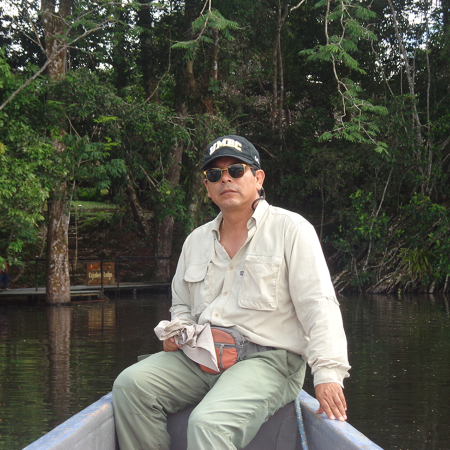
"La réserve de Cuyabeno a connu ce que j'appelle un processus de consolidation de l'intérieur de la zone protégée vers l'extérieur. Cela a commencé par la délimitation des territoires indigènes à l'intérieur de la zone protégée et l'établissement des limites de la réserve. Ensuite, plusieurs processus de renforcement de la gestion de la zone ont eu lieu, avec l'ajout de plusieurs alliés stratégiques.
Ainsi, cette consolidation a commencé avec les communautés habitant la région inférieure de la zone protégée. Suite aux processus de négociation et à la signature des premiers accords d'utilisation et de gestion des ressources naturelles en 1995, ces communautés ont commencé à définir les limites de leurs territoires et à faire partie de la cogestion de la réserve.
Parallèlement, l'expansion de la zone protégée a commencé. Au début, elle occupait 250 000 hectares, puis elle est passée à 650 000 hectares et, après un processus de rectification de ses limites, une zone de 590 112 hectares a finalement été établie, comme l'indique le plan de gestion de 2012.
Après cette étape, la délimitation physique de la zone a été réalisée et les tentatives de consolidation des limites de la région supérieure ont commencé. Trois activités ont été menées à cette fin : la résolution des conflits de propriété foncière au sein de la réserve, la délivrance d'actes dans le patrimoine forestier dans la zone extérieure de la réserve, et le contrôle et la surveillance de la zone avec le soutien des communautés locales.
C'est à ce moment-là que l'initiative du programme trinational a commencé à se développer, d'abord par des conversations entre les responsables des zones protégées frontalières de l'Équateur, du Pérou et de la Colombie, puis lors d'une réunion à Leguízamo, en Colombie, où l'on a discuté des problèmes de la région, de sa richesse environnementale, sociale et culturelle, et de l'importance de garantir sa préservation. Au cours des conversations, il est devenu évident que les trois zones avaient des situations et des problèmes très similaires, ce qui a débouché sur la possibilité de créer une méga-réserve intégrée par les trois zones protégées. Cette proposition a ensuite été présentée lors d'un atelier organisé à Leticia, en Colombie, qui a recueilli le soutien de nombreuses organisations internationales afin de consolider le programme trinational.


